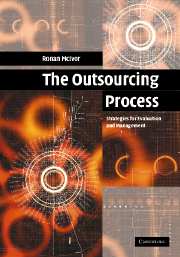Book contents
- Frontmatter
- Contents
- List of figures
- List of tables
- List of illustrations
- Acknowledgements
- 1 Introduction
- 2 The trend towards outsourcing
- 3 Theoretical influences on outsourcing
- 4 The outsourcing process: a framework for evaluation and management
- 5 Determining the current boundary of the organisation
- 6 Activity importance analysis
- 7 Capability analysis
- 8 An analysis of the strategic sourcing options
- 9 Developing the relationship strategy
- 10 Establish, manage and evaluate the relationship
- 11 Case study – outsourcing experiences at Telco
- 12 Conclusions
- Index
- References
7 - Capability analysis
Published online by Cambridge University Press: 21 August 2009
- Frontmatter
- Contents
- List of figures
- List of tables
- List of illustrations
- Acknowledgements
- 1 Introduction
- 2 The trend towards outsourcing
- 3 Theoretical influences on outsourcing
- 4 The outsourcing process: a framework for evaluation and management
- 5 Determining the current boundary of the organisation
- 6 Activity importance analysis
- 7 Capability analysis
- 8 An analysis of the strategic sourcing options
- 9 Developing the relationship strategy
- 10 Establish, manage and evaluate the relationship
- 11 Case study – outsourcing experiences at Telco
- 12 Conclusions
- Index
- References
Summary
Introduction
A major part of outsourcing evaluation is determining whether an organisation can achieve superior performance levels internally in critical activities on an on-going basis. Clearly, if the organisation can perform the activity uniquely well, then this activity should continue to be carried out internally. However, many organisations assume that because they have always performed the activity internally, then it should remain that way. In many cases, closer analysis may reveal a significant disparity between their internal capabilities and those of the world best suppliers and competitors. Organisations considering outsourcing must rigorously evaluate their capabilities in relation to both their suppliers and competitors. Analysis from an activity perspective is important given that organisations are increasingly positioning themselves in specific parts of the value chain in order to gain competitive advantage. In effect, each organisation is in competition with all potential suppliers of each activity in its value chain. In the case of a critical activity, each point in the value chain relevant to providing the activity should be assessed. Again, this analysis is concerned with identifying the disparity between the sourcing organisation and potential external sources. This analysis can identify sources of competitive advantage that can be exploited more fully by further developing certain activities. It also assists in revealing weaknesses that need to be addressed – either through internal improvement or outsourcing – to become more competitive.
- Type
- Chapter
- Information
- The Outsourcing ProcessStrategies for Evaluation and Management, pp. 146 - 182Publisher: Cambridge University PressPrint publication year: 2005

